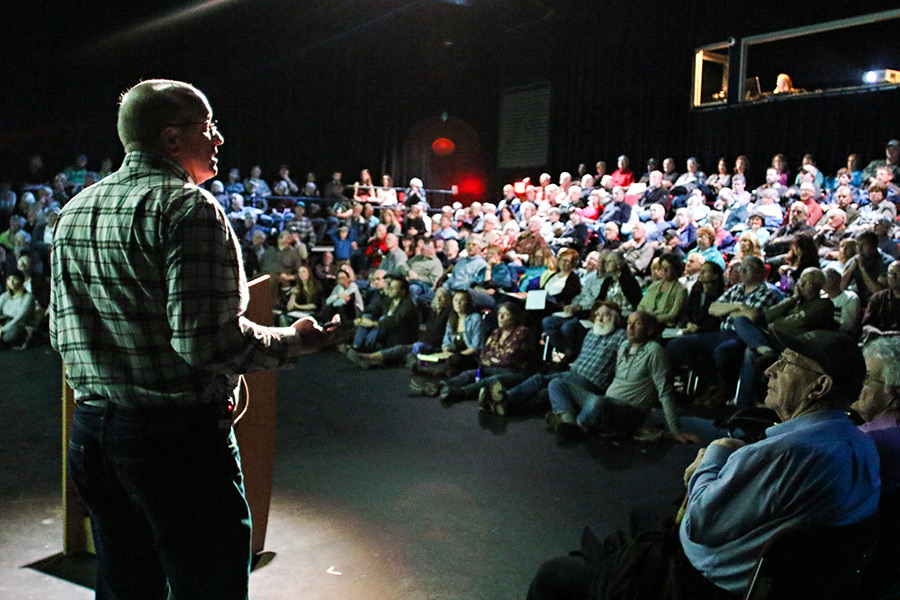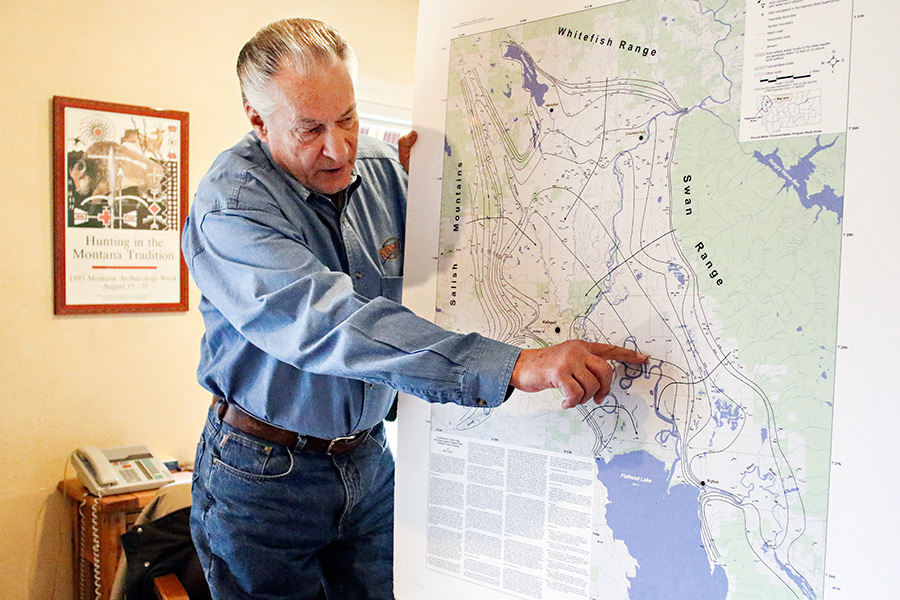Worries Run Deep as Creston Water Bottling Plant Seeks Approval
As concerns center on Flathead Valley's deep aquifer, state officials are reviewing a water rights request for a new industrial plant
By Dillon Tabish
The Flathead Valley Deep Aquifer is a waterlogged mass of sand and gravel stretching thousands of feet beneath the entire local landscape. Primarily fed by snowmelt from the surrounding mountain ranges and precipitation, the massive aquifer is the main source of water in the valley as it flows south toward Flathead Lake, providing a vital resource to a growing collective of urban and rural communities and playing a critical role in the region’s environmental and ecological balance.
For as far-reaching and abundant as the local aquifer exists, worries are running just as deep in the agricultural community of Creston and beyond following a proposed water bottling plant on a slough along the Flathead River.
Lew Weaver, the owner of Montana Artesian Water Co., is seeking a water right permit from the state to pump 710 acre-feet of water annually from the underground aquifer, the equivalent of 1.2 billion 20-ounce water bottles.
Weaver’s request, and his goal to produce 140,000 water bottles per hour, 24 hours a day, 365 days a year at a facility on his farmland, has drummed up a considerable amount of attention and is fueling concerns among neighbors and residents across the valley.
Weaver has defended his plans, saying he has followed the proper regulatory steps and studied the potential environmental consequences. He said the rinse water from the bottles would not contain contamination and that the company would generate jobs for the local economy.
“There will be a positive economic impact to Montana and the Flathead Valley. We will be employing Montanans. We will utilize Montana people and employ Montana trucking companies, and a Montana-made product will be promoted across the state,” he told the Beacon previously.
Hydrogeologists with Applied Water Consulting, the firm in charge of the permitting process for the proposed facility, have said their modeling of the deep aquifer shows that it would naturally recharge and neighboring wells would not be affected.
Last week nearly 300 people gathered at Flathead Valley Community College for a presentation that was unrelated but coincidentally about the valley’s deep aquifer. Scientists from the Montana Bureau of Mines and Geology, the agency that researches geologic, groundwater and mineral resources across the state, presented the initial findings of a two-year study of the valley’s key water source. The event, scheduled months before news of the water bottling plant surfaced, was intended as an educational presentation about the critical role the aquifer plays in the region and was not in any way connected to the water bottling controversy, according to organizers.
“The deep aquifer is a phenomenal resource that can both be used and conserved,” said John Wheaton, senior research hydrogeologist with the MBMG.
Wheaton did not go into the potential implications of the water bottling plant, but he did shed light on the vast characteristics of the deep aquifer, which “has an amazing capacity.”
On an annual basis, roughly 200,000 acre feet of water flows through the valley’s deep aquifer, Wheaton said. One acre foot is the equivalent to more than 325,000 gallons of water.
Local cities, irrigators and other water users have the rights for a total of approximately 50,000 to 55,000 acre feet of water per year from the deep aquifer, Wheaton’s research shows.
By Wheaton’s estimates, the amount of water actually pumped from the deep aquifer is closer to 17,000 to 35,000 acre feet annually with the mean average being 20,000. This reduced number is because most claim holders do not actually use their total allowable amount, he said.
Wheaton said the local aquifer is naturally and regularly recharged by Mother Nature, although there are three isolated areas that show a trend of dropping water levels where the aquifer is noticeably stressed. These areas are along the northern end of Kalispell, in a section of West Valley and near Columbia Falls.
“It’s not major but there is a downward trend (in those locations),” Wheaton said.
In areas where there is a large user who is drawing a significant amount of water, drawdown on adjacent wells can occur, Wheaton said.

Concerns have been raised in Creston that the water bottling plant could negatively impact surrounding wells. According to the plant’s water right permit application, some nearby wells could be drawn down by several feet. There is also concern that the plant’s well would only tap into the shallow aquifer, which is much smaller than the deep aquifer and could create even more drawdown.
James Rose, a hydrogeologist with MBMG, confirmed that Weaver’s well is in fact tapped into the deep aquifer; the well dives 220 feet into the ground.
“I’m pretty confident that well is in the deep aquifer,” Rose said last week. “It goes through clay into the deep system.”
The day after the FVCC presentation, another 50 people gathered inside The Church at Creston off Montana Highway 35 to ask Wheaton and Rose questions specifically about the plant and its potential impacts.
Wheaton, sticking to the science and declining to wade into any opinions, explained the scientific characteristics of the deep aquifer and how its massive identity is both impressive and important.
He said removing water from the aquifer and shipping it away in water bottles would not be significantly different than irrigating agricultural lands in terms of replenishing the water source, according to his research. Only 10 percent of water sprayed from pivot irrigation systems, and 20 percent from general sprinklers, returns to the shallow aquifer. None of the water taken from the deep aquifer in the valley floor returns to its original depths, Wheaton said.
He agreed that there are unknown challenges that could stem from climate change and emphasized the importance of creating a local monitoring program that could track the aquifer to ensure it remains abundant and balanced.
Most audience members, including all who spoke out in Creston, remained unmoved in their opposition to the plant. Several people raised concerns that other plants in the future would pop up and similarly tap into the local water supply, further impacting the vital resource. Others pointed out that much of the West is currently plagued by drought and states such as California and Texas are running dry.
“We’re concerned about the threat to our values. Our values are the quality of life in the Flathead Valley, clean and beautiful water and the nature that surrounds us,” said Sandy Perry, who lives down the road from Weaver’s property and is the chair of a new group opposing the plant, called Water for Flathead’s Future. “We see this as an unprecedented industrial-size use of water that needs to be much more carefully looked at. We would like the governor and state Legislature to look before they leap. Don’t approve this until all the questions that people have asked are addressed.”
The group is gathering signatures for a petition requesting the water right permit be held until the state can undergo a “more comprehensive analysis” and review whether the water bottle plant complies with the Montana Environmental Policy Act.
The decision, at least in terms of Weaver’s request to tap into the deep aquifer, is in the hands of the Water Resources Division of the Montana Department of Natural Resources and Conservation.
The DNRC previously issued a preliminary permit in January granting Weaver’s request, yet after news reports surfaced shining light on the water bottling plant, area residents, including water right holders, filed objections, leading the agency to extend the period for formal objections until April 7.
As of April 8, the agency had received seven objections, according to Millie Heffner, the state’s water rights bureau chief. Other objections that were postmarked on or before April 7 will be accepted.
Among those objecting include the U.S. Fish and Wildlife Service, which operates the nearby Creston Fish Hatchery. The agency filed a formal objection last month, stating the DNRC failed to properly consider adverse impacts on the hatchery, which receives most of its water from the nearby 27-acre Jesup Mill Pond, a source that is fed by 13 artesian wells. The agency says the modeling used to estimated the impact on surrounding users is flawed, and “nowhere has consideration been given to a water balance for the aquifer,” the objection states.
An online petition opposing the water bottle plant has garnered over 12,600 supporters.
Following the deadline, Heffner’s staff will now begin reviewing the objections to ensure they are valid. If an objection is missing information, the agency will send out notifications. Once objections are finalized, an administrative hearing will be scheduled locally, at which time parties from all sides will present evidence before a DNRC hearing examiner, who will review the case and determine whether to issue Weaver a water permit, which would be approved in perpetuity to the maximum requested amount of 710 acre feet per year.
In addition to the DNRC permit, Montana Artesian Water Company has applied with the Department of Environmental Quality for permitting under the Montana Pollutant Discharge Elimination System. It would need to be licensed by the Department of Public Health and Human Resources as a food-grade facility, which would be the final regulatory hurdle for Weaver’s company.